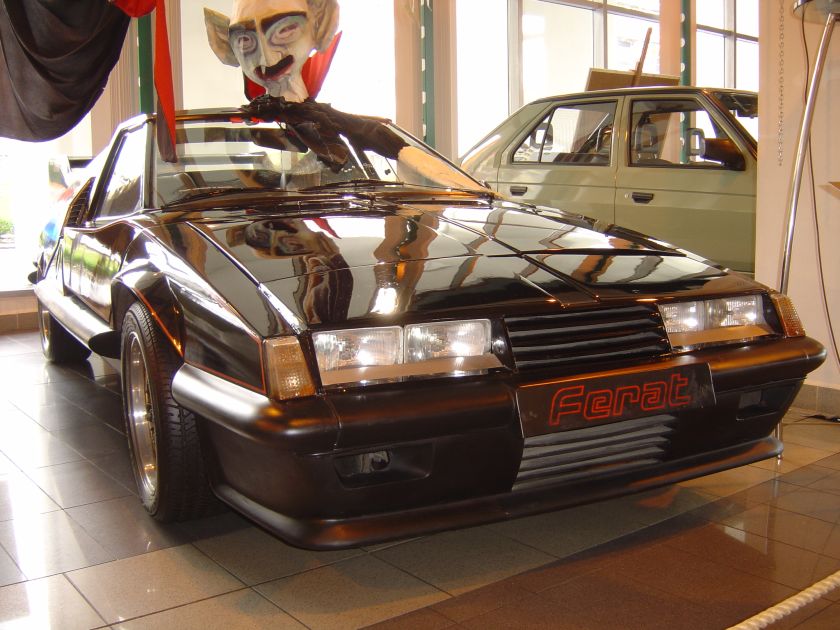|
҆koda 110 Super Sport
The ҆koda 110 Super Sport (type 724) was a prototype sports car with rear engine and rear wheel drive, development took place in 1969-1971 and a prototype was produced in 1971. The car had an aerodynamic body made of fiberglass, there were six flip-up headlights in front, and behind it there was space for luggage and a spare wheel. The doors flipped up along with the windshield and roof. In the rear part of the car there was an engine - an in-line four-cylinder from the ҆koda 110 L Rallye. For testing purposes, a more powerful 1147 cm¬≥ engine was temporarily installed in the car. There were 16 round lights on the rear end, 6 in the upper row at the edge of three and 10 in the lower row across the entire width of the car. A single specimen was produced in Kvasiny, which was white in color. It was introduced in 1972 at the Brussels Motor Show. Despite the public interest, it did not make it into serial production. In Czechoslovakia, the car was criticized for too angular shapes, ... [...More Info...] [...Related Items...] OR: [Wikipedia] [Google] [Baidu] |
Upír Z Feratu
''Up√≠r z Feratu'', also known as ''Ferat Vampire'' is a 1982 Czechoslovak horror film directed by Juraj Herz. The name is a pun on ''Up√≠r Nosferatu'', or ''Nosferatu, Nosferatu the Vampire''. Plot Doctor Marek (JiŇô√≠ Menzel) is shocked when his beloved nurse, Mima (Dagmar Havlov√°, Dagmar VeŇ°krnov√°), signs a contract with foreign car manufacturer Ferat to work as a rally-driver. Rumors abound that the Ferat sports car runs not on petrol, but on human blood. Cast * JiŇô√≠ Menzel as Dr. Marek * Dagmar Havlov√°, Dagmar VeŇ°krnov√° as Mima * Jana BŇôeŇĺkov√° as Luisa / Kl√°ra * Petr ńĆepek as KŇô√≠Ňĺ * Jan Schmid as Dr. Kaplan * Zdenka Proch√°zkov√° as Madame Ferat Production The Ferat rally car used in the film was, in fact, a prototype for an unrealized sports model ҆koda 110 Super Sport produced by ҆koda Auto, now generally referred to as the ҆koda Super Sport 'Ferat Vampir RSR' in homage to the film. This car white coloured also play a small role in ''Tomorrow I'll Wak ... [...More Info...] [...Related Items...] OR: [Wikipedia] [Google] [Baidu] |
Tomorrow I'll Wake Up And Scald Myself With Tea
''Tomorrow I'll Wake Up and Scald Myself with Tea'' () is a 1977 Czechoslovak comical science fiction film directed by JindŇôich Pol√°k. It is a screen adaptation of Josef Nesvadba's short story with the same title. on FDB.cz Plot In the near future, a technology enabling has been developed and is now in commercial use. A group of unaging (thanks to anti-aging pills, which have also been developed) |
Disc Brake
A disc brake is a type of brake that uses the #Calipers, calipers to squeeze pairs of #Brake pads, pads against a disc (sometimes called a [brake] rotor) to create friction. There are two basic types of brake pad friction mechanisms: abrasive friction and adherent friction. This action slows the rotation of a shaft, such as a vehicle axle, either to reduce its rotational speed or to hold it stationary. The energy of motion is converted into heat, which must be dissipated to the environment. Hydraulic brakes, Hydraulically Actuator, actuated disc brakes are the most commonly used mechanical device for slowing motor vehicles. The principles of a disc brake apply to almost any rotating shaft. The components include the disc, master cylinder, and caliper, which contain at least one cylinder and two Brake pad, brake pads on both sides of the rotating disc. Design The development of disc-type brakes began in England in the 1890s. In 1902, the Lanchester Motor Company designed bra ... [...More Info...] [...Related Items...] OR: [Wikipedia] [Google] [Baidu] |
Drum Brake
A drum brake is a brake that uses friction caused by a set of Brake shoe, shoes or Brake pad, pads that press outward against a rotating bowl-shaped part called a brake drum. The term ''drum brake'' usually means a brake in which shoes press on the Brake lining, inner surface of the drum. When shoes press on the outside of the drum, it is usually called a ''Railway brake, clasp brake''. Where the drum is pinched between two shoes, similar to a conventional disc brake, it is sometimes called a ''pinch drum brake'', though such brakes are relatively rare. A related type called a band brake uses a flexible belt or "band" wrapping around the outside of a drum. History The modern automobile drum brake was first used in a car made by Wilhelm Maybach, Maybach in 1900, although the principle was only later patented in 1902 by Louis Renault (industrialist), Louis Renault. He used woven asbestos lining for the drum brake lining, as no alternative material dissipated heat more effectivel ... [...More Info...] [...Related Items...] OR: [Wikipedia] [Google] [Baidu] |
҆koda Vehicles
҆koda means "pity" in the Czech and Slovak languages. It may also refer to: Czech brands and enterprises * ҆koda Auto, automobile and previously bicycle manufacturer in Mlad√° Boleslav ** ҆koda Motorsport, the division of ҆koda Auto responsible for motorsport activities * ҆koda Transportation, engineering company that manufactures rail vehicles, based in PlzeŇą * ҆koda Works, engineering company, predecessor of ҆koda Transportation * ҆koda-Kauba, aircraft manufacturing subsidiary of the ҆koda Works in occupied Czechoslovakia in World War II * Doosan ҆koda Power, subsidiary of the Doosan Group, based in PlzeŇą People * ҆koda (surname) * Skoda (Portuguese footballer) (born 1960) Art * ''҆koda l√°sky'', the original Czech title of the "Beer Barrel Polka" Other * British Rail Class 90 The British Rail Class 90 is a type of electric locomotive. They were built for mixed-traffic duties, operating from overhead lines and producing . They weigh 84.5tonnes and can ty ... [...More Info...] [...Related Items...] OR: [Wikipedia] [Google] [Baidu] |

